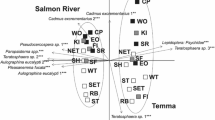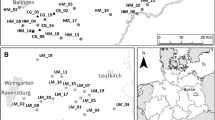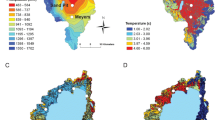Abstract
Genetic diversity is the foundation of all biodiversity, and the genetic variation within species is increasingly recognized as being important to ecosystem level processes. Recent research demonstrates that plant genotype influences above- and belowground communities as well as basic ecosystem functions. However, the extent to which plant genotypes create spatial mosaics of genetically mediated ecosystem processes in natural forests is uncertain. We use Populus tremuloides as a model system to demonstrate the importance of plant genotype on carbon and nitrogen cycling in natural systems. We identified 24 distinct P. tremuloides clones with multiple ramets across 25 km2 in southern Wisconsin, United States, using microsatellite makers. We then sampled clone leaf chemistry and belowground nutrient content and microbial extracellular enzyme activity. Aspen-induced variation in belowground carbon and nitrogen content, and microbial activity, varied widely among clones. Variation in green leaf chemistry and belowground microbial activity were correlated with genetic distance among clones, such that more genetically distant clones created more divergent patches of ecosystem processes. These data suggest that aspen genotypes create spatial mosaics of genetically mediated ecosystem functioning across natural landscapes and can therefore have evolutionary consequences for co-occurring species.


Similar content being viewed by others
References
Allison SD, Vitousek PM (2005) Responses of extracellular enzymes to simple and complex nutrient inputs. Soil Biol Biochem 37:937–944
Bailey JK, Wooley SC, Lindroth RL, Whitham TG (2006) Importance of species interactions to community heritability: a genetic basis to trophic-level interactions. Ecol Lett 9:78–85
Bangert RK, Turek RJ, Martinsen GD, Wimp GM, Bailey JK, Whitham TG (2005) Benefits of conservation of plant genetic diversity to arthropod diversity. Conserv Biol 19:379–390
Bangert RK, Allan GJ, Turek RJ, Wimp GM, Meneses N, Martinsen GD, Keim P, Whitham TG (2006a) From genes to geography: a genetic similarity rule for arthropod community structure at multiple geographic scales. Mol Ecol 15:4215–4228
Bangert RK, Turek RJ, Rehill B, Wimp GM, Schweitzer JA, Allan GJ, Bailey JK, Martinsen GD, Keim P, Lindroth RL, Whitham TG (2006b) A genetic similarity rule determines arthropod community structure. Mol Ecol 15:1379–1391
Bangert RK, Lonsdorf EV, Wimp GM, Shuster SM, Fischer D, Schweitzer JA, Allan GJ, Bailey JK, Whitham TG (2008) Genetic structure of a foundation species: scaling community phenotypes from the individual to the region. Heredity 100:121–131
Benoit RE, Starkey RL (1968) Enzyme inactivation as a factor in the inhibition of decomposition of organic matter by tannins. Soil Sci 105:203–208
Booth RE, Grime JP (2003) Effects of genetic impoverishment on plant community diversity. J Ecol 91:721–730
Brinkmann K, Blaschke L, Polle A (2002) Comparison of different methods for lignin determination as a basis for calibration of near-infrared reflectance spectroscopy and implications of lignoproteins. J Chem Ecol 28:2483–2501
Cadisch G, Giller KE (1997) Driven by nature: plant litter quality and decomposition. CAB International, Wallingford
Carreiro MM, Sinsabaugh RL, Repert DA, Parkhurst DF (2000) Microbial enzyme shifts explain litter decay responses to simulated nitrogen deposition. Ecology 81:2359–2365
Classen AT, Chapman SK, Whitham TG, Hart SC, Koch GW (2007) Genetic-based plant resistance and susceptibility traits to herbivory influence needle and root litter nutrient dynamics. J Ecol 95:1181–1194
Cole CT (2005) Allelic and population variation of microsatellite loci in aspen (Populus tremuloides). New Phytol 167:155–164
Coleman DC, Crossley DA Jr (1996) Fundamentals of soil ecology. Academic, New York
Crutsinger GM, Collins MD, Fordyce JA, Gompert Z, Nice CC, Sanders NJ (2006) Plant genotypic diversity predicts community structure and governs an ecosystem process. Science 313:966–968
Dawkins R (1976) The selfish gene. Oxford University Press, Oxford
Dawkins R (1982) The extended phenotype. Oxford University Press, Oxford
Dieringer D, Schlotterer C (2003) MICROSATELLITE ANALYSER (MSA): a platform independent analysis tool for large microsatellite data sets. Mol Ecol Notes 3:167–169
Dungey HS, Potts BM, Whitham TG, Li HF (2000) Plant genetics affects arthropod community richness and composition: evidence from a synthetic eucalypt hybrid population. Evolution 54:1938–1946
Fischer DG, Hart SC, LeRoy CJ, Whitham TG (2007) Variation in below-ground carbon fluxes along a Populus hybridization gradient. New Phytol 176:415–425
Hagerman AE, Butler LG (1989) Choosing appropriate methods and standards for assaying tannin. J Chem Ecol 15:1795–1810
Hobbie SE (1992) Effects of plant species on nutrient cycling. Trends Ecol Evol 7:336–339
Holderegger R, Kamm U, Gugerli F (2006) Adaptive vs. neutral genetic diversity: implications for landscape genetics. Landsc Ecol 21:797–807
Hughes AR, Inouye BD, Johnson MTJ, Underwood N, Vellend M (2008) Ecological consequences of genetic diversity. Ecol Lett 11:609–623
Iason GR, Lennon JJ, Pakeman RJ, Thoss V, Beaton JK, Sim DA, Elston DA (2005) Does chemical composition of individual Scots pine tree determine the biodiversity of their associated ground vegetation? Ecol Lett 8:364–369
Johnson MTJ, Agrawal AA (2005) Plant genotype and environment interact to shape a diverse arthropod community on evening primrose (Oenothera biennis). Ecology 86:874–885
Johnson MTJ, Stinchcombe JR (2007) An emerging synthesis between community ecology and evolutionary biology. Trends Ecol Evol 22:250–257
Johnson MTJ, Lajeunesse MJ, Agrawal AA (2006) Additive and interactive effects of plant genotypic diversity on arthropod communities and plant fitness. Ecol Lett 9:24–34
Kraus TEC, Dahlgren RA, Zasoski RJ (2003) Tannins in nutrient dynamics of forest ecosystems—a review. Plant Soil 256:41–66
Lankau RA, Strauss SY (2007) Mutual feedbacks maintain both genetic and species diversity in a plant community. Science 317:1561–1563
Lindroth RL, Kinney KK, Platz CL (1993) Responses of deciduous trees to elevated atmospheric CO2-productivity, phytochemistry, and insect performance. Ecology 74:763–777
Lindroth RL, Osier TL, Barnhill HRH, Wood SA (2002) Effects of genotype and nutrient availability on phytochemistry of trembling aspen (Populus tremuloides Michx.) during leaf senescence. Biochem Syst Ecol 30:297–307
Madritch MD, Hunter MD (2002) Phenotypic diversity influences ecosystem functioning in an oak sandhills community. Ecology 83:2084–2090
Madritch MD, Hunter MD (2004) Phenotypic diversity and litter chemistry affect nutrient dynamics during litter decomposition in a two species mix. Oikos 105:125–131
Madritch MD, Donaldson JR, Lindroth RL (2006) Genetic identity of Populus tremuloides litter influences decomposition and nutrient release in a mixed forest stand. Ecosystems 9:528–537
Madritch MD, Donaldson JR, Lindroth RL (2007) Canopy herbivory can mediate the influence of plant genotype on soil processes through frass deposition. Soil Biol Biochem 39:1192–1201
Merila J, Crnokrak P (2001) Comparison of genetic differentiation at marker loci and quantitative traits. J Evol Biol 14:892–903
Mitton JB, Grant MC (1996) Genetic variation and the natural history of quaking aspen. Bioscience 46:25–31
Porter L, Hrstrich L, Chan B (1986) The conversion of procyanidins and prodelphinidins to cyanidin and delphinidin. Phytochemistry 25:223–230
Priha O, Grayston SJ, Hiukka R, Pennanen T, Smolander A (2001) Microbial community structure and characteristics of the organic matter in soils under Pinus sylvestris, Picea abies, and Betula pendula at two forest sites. Biol Fertil Soils 33:17–24
Reed DH, Frankham R (2001) How closely correlated are molecular and quantitative measures of genetic variation? A meta-analysis. Evolution 55:1095–1103
Saiya-Cork KR, Sinsabaugh RL, Zak DR (2002) The effects of long term nitrogen deposition on extracellular enzyme activity in an Acer saccharum forest soil. Soil Biol Biochem 34:1309–1315
Schweitzer JA, Bailey JK, Rehill BJ, Martinsen GD, Hart SC, Lindroth RL, Keim P, Whitham TG (2004) Genetically based trait in a dominant tree affects ecosystem processes. Ecol Lett 7:127–134
Schweitzer JA, Bailey JK, Hart SC, Wimp GM, Chapman SK, Whitham TG (2005) The interaction of plant genotype and herbivory decelerate leaf litter decomposition and alter nutrient dynamics. Oikos 110:133–145
Schweitzer JA, Bailey JK, Fischer DG, Leroy CJ, Lonsdorf EV, Whitham TG, Hart SC (2008) Plant-soil-microorganism interactions: heritable relationship between plant genotype and associated soil microorganisms. Ecology 89:773–781
Shuster SM, Lonsdorf EV, Wimp GM, Bailey JK, Whitham TG (2006) Community heritability measures the evolutionary consequences of indirect genetic effects on community structure. Evolution 60:991–1003
Sinsabaugh RL, Reynolds H, Long TM (2000) Rapid assay for amidohydrolase (urease) activity in environmental samples. Soil Biol Biochem 32:2095–2097
Smulders M, van der Schoot J, Arens P, Vosman B (2001) Trinucleotide repeat microsatellite makers for black poplar (Populus nigra L.). Mol Ecol Notes 1:188–190
Stiling P, Rossi AM (1995) Coastal insect herbivore communities are affected more by local environmental conditions than by plant genotype. Ecol Entomol 20:184–190
Templer P, Findlay S, Lovett G (2003) Soil microbial biomass and nitrogen transformations among five tree species of the Catskill Mountains, New York, USA. Soil Biol Biochem 35:607–613
Thompson JN (1999) The evolution of species interactions. Science 284:2116–2118
Thompson JN (2005) The geographic mosaic of coevolution. University of Chicago Press, Chicago
Tuskan GA, Gunter LE, Yang ZK, Yin TM, Sewell MM, DiFazio SP (2004) Characterization of microsatellites revealed by genomic sequencing of Populus trichocarpa. Can J For Res 34:85–93
Vogt KA, Vogt DJ, Asbjornsen H, Dalgren RA (1995) Roots, nutrients and their relationship to spatial patterns. Plant Soil 168:113–123
Waldrop MP, Zak DR, Sinsabaugh RL (2004) Microbial community response to nitrogen deposition in northern temperate forests. Soil Biol Biochem 36:1443–1451
Wehenkel C, Bergmann F, Gregorius HR (2006) Is there a trade-off between species diversity and genetic diversity in forest tree communities? Plant Ecol 185:151–161
Whitham TG, Young WP, Martinsen GD, Gehring CA, Schweitzer JA, Shuster SM, Wimp GM, Fischer DG, Bailey JK, Lindroth RL, Woolbright S, Kuske CR (2003) Community and ecosystem genetics: a consequence of the extended phenotype. Ecology 84:559–573
Whitham TG, Bailey JK, Schweitzer JA, Shuster SM, Bangert RK, Leroy CJ, Lonsdorf EV, Allan GJ, DiFazio SP, Potts BM, Fischer DG, Gehring CA, Lindroth RL, Marks JC, Hart SC, Wimp GM, Wooley SC (2006) A framework for community and ecosystem genetics: from genes to ecosystems. Nat Rev Genet 7:510–523
Wimp GM, Young WP, Woolbright SA, Martinsen GD, Keim P, Whitham TG (2004) Conserving plant genetic diversity for dependent animal communities. Ecol Lett 7:776–780
Wimp GM, Martinsen GD, Floate KD, Bangert RK, Whitham TG (2005) Plant genetic determinants of arthropod community structure and diversity. Evolution 59:61–69
Acknowledgments
Funding was provided by an REU supplement to NSF DEB-0344019 to R.L.L. and M.D.M. We thank the Pine Island Wildlife Area and the Wisconsin Department of Natural Resources for site use permission. All experiments comply with the current laws of the country in which they were performed.
Author information
Authors and Affiliations
Corresponding author
Additional information
Communicated by Amy Austin.
Rights and permissions
About this article
Cite this article
Madritch, M.D., Greene, S.L. & Lindroth, R.L. Genetic mosaics of ecosystem functioning across aspen-dominated landscapes. Oecologia 160, 119–127 (2009). https://doi.org/10.1007/s00442-009-1283-3
Received:
Accepted:
Published:
Issue Date:
DOI: https://doi.org/10.1007/s00442-009-1283-3




